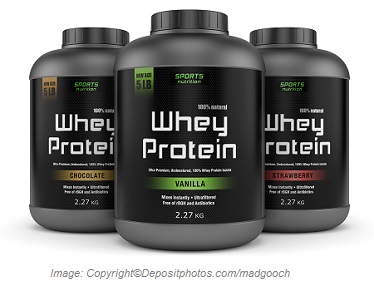 Whey is the white – yellowish liquid part of milk after removing casein protein during the process of making cheese. It is a watery portion of milk separated from curds. In fact, it is a by – product of cheese production.
Whey is the white – yellowish liquid part of milk after removing casein protein during the process of making cheese. It is a watery portion of milk separated from curds. In fact, it is a by – product of cheese production.Constituents:
Whey protein is the second common protein in cow`s milk (20% whey compared to 80% casein). The protein fractions of whey include:
Beta – Lactoglobulin (55 – 60%).
Alpha – Lactalbumin (15 – 20%).
Glycomacropeptide (10 – 20%).
Bovine Serum Albumin (3 – 7%).
Immunoglobulins (3 – 4%).
Lactoferrin (1%).
Lactoperoxidase (1%).
Amino acid compositions of whey, casein, soy, and egg proteins are different (see the table below).
|
Amino Acid Compositions of Whey, Casein, Soy, and Egg Proteins (% per 100 grams): |
||||
|
Amino acids |
Whey |
Casein |
Soy |
Egg |
|
Alanine |
4.6 |
2.7 |
3.8 |
5.5 |
|
Arginine |
2.3 |
3.7 |
6.7 |
5.9 |
|
Aspartic acid |
9.6 |
6.4 |
10.2 |
10 |
|
Cysteine |
2.8 |
0.3 |
1.1 |
2.3 |
|
Glutamic acid |
15 |
20.2 |
16.8 |
13 |
|
Glycine |
1.5 |
2.4 |
3.7 |
3.3 |
|
Histidine |
1.6 |
2.8 |
2.3 |
2.3 |
|
Isoleucine |
4.5 |
5.5 |
4.3 |
5.3 |
|
Leucine |
11.6 |
8.3 |
7.2 |
8.4 |
|
Lysine |
9.1 |
7.4 |
5.5 |
7.1 |
|
Methionine |
2.2 |
2.5 |
1.1 |
3.0 |
|
Phenylalanine |
3.1 |
4.5 |
4.6 |
5.2 |
|
Proline |
4.4 |
10.2 |
4.5 |
3.9 |
|
Serine |
3.3 |
5.7 |
4.6 |
7.3 |
|
Threonine |
4.3 |
4.4 |
3.3 |
4.7 |
|
Tryptophan |
2.3 |
1.1 |
1.1 |
1.1 |
|
Tyrosine |
3.3 |
5.7 |
3.3 |
4.0 |
|
Valine |
4.5 |
7.6 |
4.5 |
6.0 |
Digestibility and Advantages:
Whey protein is easily dissolved in water, making it convenient mix with any drinks without excessive clumping. It is digested rapidly. Whey protein leaves the stomach much faster than casein and soy, leading to a rapid but short – term spike in amino acid pools of the body, which makes it the preferred protein for muscle recovery after exercise. This is why whey protein is sometimes called “fast protein”.
Also whey protein has the highest biologic value, making it an excellent protein for building muscles and boosting body metabolism.
Another advantage of whey protein is that it provides high amounts of leucine, the most important BCAA (branched – chain amino acid) used by the body during exercise, calorie restriction, trauma, and infections. It is because leucine breaks down to HMB (beta-Hydroxy beta-Methylbutyrate).
For more information about HMB, see the “HMB” under the section of “Sports – Performance Enhancers”.
Types of Whey Proteins:
There are four types of whey proteins: isolate, concentrate, hydrolysate, and blend. Whey proteins isolate and blend are the most commonly consumed forms.
Whey protein isolate (WPI) contains a trace amount of fat, has a small amount of carbohydrate, is less allergenic, and has a faster absorption.
Whey protein concentrate (WPC) has small amounts of fat and some carbohydrates, is more allergenic than WPI, and has lower rate of absorption compared to WPI.
Whey protein hydrolysate (WPH) is a predigested form, has slightly bitter taste, and is the least allergenic form.
Whey protein blend (WPB) is a mixture of two or three other forms of whey.
|
Macronutrient Compositions of Different Types of Whey Proteins (per 30 grams of powder): |
||||
|
Nutrients (gr) |
Isolate |
Concentrate |
Hydrolysate |
Blend |
|
Protein |
27 – 29 |
18 -20 |
25 – 27 |
20 – 22 |
|
Carbohydrates |
0.5 – 1.0 |
5 – 6 |
0 – 0.5 |
3 – 5 |
|
Fat |
0.1 – 0.5 |
1 – 2 |
0 – 0.5 |
1 – 2 |
Indications for Using Whey Protein: 
Whey protein is an immune booster and can be used in a wide variety of conditions.
Athletic Indications of Whey Protein:
1) To increase muscle mass.
2) For post – exercise recovery.
3) To prevent from overtraining syndrome.
4) To boost body metabolism.
Non – Athletic Indications of Why Protein:
The following conditions may benefit from whey protein:
1) Weight management.
2) Muscle wasting diseases.
3) Compromised immune system.
4) End stages of cancers.
5) Vegetarians.
How to Take Whey Protein:
Due to versatility of whey protein, it is usually added to varieties of foods and beverages. You may incorporate whey protein into your diet as a supplement especially if you are not getting enough protein through your foods.
Whey protein is available with or without flavors. It is a personal preference to choose any of them. You can mix your whey protein with water, milk, or any other drinks, or even you could make a smoothie with it.
A common strategy among athletes and gym – goers is to take whey protein upon waking up in the morning and within 30 minutes after exercise or competition. If you are a non – athletic person, you may take it as snacks or along with your meals. For providing “the right amount of protein” to your body, try to rely on your foods. If you are unable to get sufficient amounts from your diet, then you can incorporate whey protein in your eating program.
Interactions and Cautions:
Whey protein may demonstrate interactions with the following medications: 
- Levodopa: this medication is used to treat Parkinson`s disease. Whey protein may decrease the absorption and effectiveness of Levodopa. They should not be taken at the same time!
- Bisphosphonates: these medications are used to increase bone density in Osteoporosis. Whey protein may decrease their absorption and effectiveness. They should be taken minimum 2 hours apart. These medications are:
- Alendronate.
- Etidronate.
- Pamidronate.
- Residronate.
- Tiludronate.
- Zoledronic acid.
- Antibiotics: whey protein may interact with the following antibiotics and slow down their absorption:
- Quinolones: ciprofloxacin, enoxacin, gemifloxacin, grepafloxacin, norfloxacin, ofloxacicn, and trovafloxacin.
- Tetracyclines: demeclocycline, doxycycline, minocycline, and tetracycline.
Whey protein should be used with extreme caution in the following medical conditions:
- Liver diseases.
- Kidney diseases.
- Chronic pancreatitis.
- Hartnup syndrome.
- Cystinuria
- Along with corticosteroids.
Whey protein should be avoided in the following medical conditions:
- Acute renal failure.
- Hepatic encephalopathy.
- Diabetic nephropathy.
- Rhabdomyolysis (post – trauma/exercise myoglobinuria). See “Post – Exercise Rhabdomyolysis” under the section of “Athletic Disorders”.
How to Choose Whey Protein:
When purchasing whey protein, we strongly recommend you pay attention carefully to the following points:
- The increasing demand and usage of whey protein as an ingredient require removing its color and flavor. For this purpose, whey bleaching agents are used. They are benzoyl peroxide (BP) and hydrogen peroxide (HP). In other words, these agents are used to bleach liquid whey before drying it out into powder. BP is more effective in removing the color of whey. However, it breaks down to benzoic acid (BA), which may be found in a trace amount in bleached whey powder. Choose a benzoyl peroxide – free whey powder.
- Long – term consumption of whey protein may deplete calcium from the body. Choose a whey powder with calcium in it. The amount of calcium in whey powders should be 10 – 20% of daily value.
- For better digestion and absorption, choose a whey powder that contains digestive enzymes.
Side Effects:
In general, whey protein is considered safe. However, nothing is risk free. The side effects are minimal. If you are an occasional consumer of whey protein, you may not experience any unwanted effects. But if you are a regular and heavy consumer of whey protein, you might experience few side effects:
Short – term side effects:
- Allergic reactions.
- Nausea.
- Bloating.
- Abdominal cramps.
- Fatigue.
- Diarrhea.
- Constipation.
- Headaches.
Long – term side effects:
- Dehydration.
- Increased urinary loss of calcium.
- Increased propensity of developing Osteoporosis.
- Deterioration of previously existed kidney and liver diseases.

